| Pages:
1
..
27
28
29
30
31 |
Dan Vizine
National Hazard
   
Posts: 628
Registered: 4-4-2014
Location: Tonawanda, New York
Member Is Offline
Mood: High Resistance
|
|
Quote: Originally posted by lysander  | For my fourth attempt I tried the Brauer/Vizine formula, which essentially doubles the amount of ferrocyanide but still uses a 25% dilution of H2SO4.
Combine 100mL distilled water with 100mL H2SO4. This reaction heats the dilute to 100C. Therefore wait for it to cool back to room temperature
Add 211g K4FE(CN)6 trihydrate to 1 liter boiling flask.
Add 200mL water and begin stirring. (This requires a more powerful stirrer).
Add the cooled 200mL H2SO4 dilute to boiling flask.
Heat solution to 60C.
Run for <i>four hours</i>. <B><I>Nothing</B></I> evolved!
Raised heat to 80C. Managed to get 15mL of condensate in cooled collection flask that smells of HCN, but also of something more strong and
pungent.
Hang head in disappointment.
Here's a photo of the apparatus running after about an hour:
The color gets perhaps a <i>little</i> darker by the end, as seen in this video taken right before shutdown:
http://youtu.be/dTFK_o-D_JI
(Compare that color to the two runs where I dropped the concentrated H2SO4 into the ferricyanide solution:
http://youtu.be/SqLJU862yMQ
Questions:
A. Does the color indicate any failure? What is the expected progression of color over the course of the reaction?
B. Is HCN miscible with H2SO4? (If not that would explain the two layers I'm getting in what little I collect.)
[Edited on 15-9-2015 by lysander] |
Regarding A)
I have never observed that color at any stage. When the ferricyanide was added to stirred, hot 25% sulfuric acid (or the reverse, it makes no
difference) the suspension turns deep blue very quickly. The ~ 60 C blue mixture foams during the first hour when HCN evolution is fastest. Thereafter
the mixture seems to thicken and the bubbles are very tenacious. Heating can then be increased (above 60 C) if desired, but this can bring over more
H2O. I add Dow Corning anti-foam agent and it may help a little. I find that it is necessary to watch the process closely throughout as stirring
speed needs frequent adjustment. Are you always able to keep the suspension actively stirring? Don't confuse the sound of a rattling, but stuck, stir
bar with one that is stirring. Sometimes it's necessary to glimpse the stirring magnet of your stirrer, just to know if it's working, or not (spinning
very fast as it decoupled from the stirring bar which was formerly stirring a thick bubbling slush and so had the stirring plate set rather high to
provide the needed torque).
P.S. See the above answers re. my use of copper metal instead of CuCl. It may have helped, it certainly didn't hurt.
And B) HCN, water, sulfuric acid are mutually miscible in all proportions.
I still strongly suggest a heating source that completely surrounds the flask, an oil bath is the easiest, cheapest soln.
[Edited on 20-9-2015 by Dan Vizine]
"All Your Children Are Poor Unfortunate Victims of Lies You Believe, a Plague Upon Your Ignorance that Keeps the Youth from the Truth They
Deserve"...F. Zappa
|
|
|
lysander
Hazard to Self
 
Posts: 69
Registered: 12-7-2015
Member Is Offline
Mood: No Mood
|
|
Quote: Originally posted by Dan Vizine  | | I have never observed that color at any stage. When the ferricyanide was added to stirred, hot 25% sulfuric acid (or the reverse, it makes no
difference) the suspension turns deep blue very quickly. |
This might be a key to solving my ongoing failure. For attempt #5 tonight I put all liquid in the boiling flask first, and then began to add the
ferrocyanide with the mixer going. (I can always see the mixer working because I can see the vortex.) It was turning blue as it was being added,
until I increased the rate of addition at which point it became briefly milky before starting to turn light green.
Of course yellow + blue = green, but it's not just a failure of the yellow ferrocyanide to react. Something else is going on, because after removing
the addition funnel I wafted the opening towards my nose: again, overwhelming the hint of HCN was something far more pungent -- the same nauseating
thing that overwhelmed the HCN odor in the past condensed fractions that have two immiscible layers. I can't put my finger on it, but I think it is
also present in the smoke of burning garbage containing plastics.
Suffice it to say that I think the mixing of the reagents has to be done in a more controlled fashion than documented anywhere yet. Although,
embarrassingly, that's not quite true: Ledgard's instructions, of all things, noted that the H2SO4 dilute should be added dropwise to the mixing
solution of the ferrocyanide.
Maybe sixth time's the charm? 
[Edited on 20-9-2015 by lysander]
|
|
|
Dan Vizine
National Hazard
   
Posts: 628
Registered: 4-4-2014
Location: Tonawanda, New York
Member Is Offline
Mood: High Resistance
|
|
You're using the ferrocyanide?
Stupid me, I thought you were using the ferricyanide (orange-red).
While both will give HCN ultimately, you can't just assume a procedure specific to the ferricyanide will be correct for the ferrocyanide.
"All Your Children Are Poor Unfortunate Victims of Lies You Believe, a Plague Upon Your Ignorance that Keeps the Youth from the Truth They
Deserve"...F. Zappa
|
|
|
lysander
Hazard to Self
 
Posts: 69
Registered: 12-7-2015
Member Is Offline
Mood: No Mood
|
|
Quote: Originally posted by Dan Vizine  | You're using the ferrocyanide?
Stupid me, I thought you were using the ferricyanide (orange-red).
While both will give HCN ultimately, you can't just assume a procedure specific to the ferricyanide will be correct for the ferrocyanide.
|
Well my first two tests were with ferricyanide. Then since all other sources indicated ferrocyanide, and with the same specifications, I used that for #3-5.
Meanwhile, I combined and ran a single distillation of the fractions from all runs to date. Most of the liquid boiled about 30C as expected,
producing 50mL of condensate. The "other immiscible stuff" remained in the boiling flask, so I poured it over a thin layer of NaOH. It reacted
violently. I put the resulting deliquescent mass in a freezer and might try to assay it further sometime....
[Edited on 21-9-2015 by lysander]
|
|
|
lysander
Hazard to Self
 
Posts: 69
Registered: 12-7-2015
Member Is Offline
Mood: No Mood
|
|
Well if there's an award for worst experimental chemist I'd like to nominate myself. I've tried every formulation I can find documented of reacting
K-ferrocyanide with H2SO4 to produce HCN. I even carefully followed Williams to include a CuCl catalyst dissolved in HCl. No matter what I do I can't get more than about 10mL of HCN from 200g of K-ferrocyanide or
-ferricyanide. Running longer or hotter just gets more water.
"Well fine," I thought. "I'll go back to the old-school method of boiling it off of cyan-salts with H2SO4." So I smelted up a nice batch of
K-ferrocyanide with Na2CO3, then dripped H2SO4 into the results. Turns out there's more that reacts with H2SO4 in the byproducts (carbon and iron
compounds) than just the cyan-salts. Also turns out a Liebig condenser isn't adequate to condense whatever it is that boils off.
Also turns out that it leaves some black residue in the reaction flask that neither acids nor bases nor detergents will remove. Any ideas on other
compounds that might clean this?
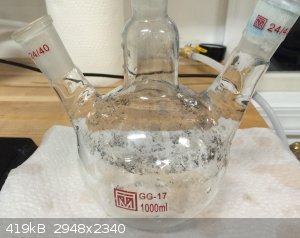
|
|
|
Heavy Walter
Hazard to Others
  
Posts: 127
Registered: 17-12-2015
Location: Argentina
Member Is Offline
Mood: No Mood
|
|
Hi
See this:
http://www.ehs.wisc.edu/chem/GlasswareCleaning.pdf
|
|
|
Dan Vizine
National Hazard
   
Posts: 628
Registered: 4-4-2014
Location: Tonawanda, New York
Member Is Offline
Mood: High Resistance
|
|
Lysander, use bleach. It's highly effective.
As I've been waiting for the winter to end so that I can finally complete the thorium production run (since it's going to be done outside, no question
about it), I thought I'd do a relatively safe reaction during the cold winter months.
There have been an incredible number of verbal descriptions for the production of hydrogen cyanide from common chemicals. Personally, I've never had
any luck at all with the industrial approaches starting with urea and sodium carbonate, and performed over a hot fire. I'm sure that it works, but
control on the reaction variables and what values that those variables should be held at is difficult to determine. I've clearly smelled that
wonderful almond smell in the crude product, but after isolation it was really just pure garbage.
From my standpoint, given the available precursors, the only logical method is potassium ferricyanide plus hot sulfuric acid and, as I have earlier in
this thread described the ratios of reactants and concentration of acid and how I performed the reaction and over how long, I want to just share with
you a few pictures of a successful run since there seem to be so many questions about the technique and not the actual chemistry.
In the heavily labeled picture below you can see the actual setup that I used. The exhaust tube simply runs outside via a port in my basement window.
Mechanical stirring makes this reaction incredibly much easier to do than it is with magnetic stirring. The nature of the stirred mixture changes in a
relatively complex way. The reaction mixture starts out as a spectacularly blue colored liquid which gradually changes to a heavy suspension which is
evolving gaseous hydrogen cyanide. This can lead to substantial foaming and even the use of silicone anti-foaming agents is only moderately successful
at minimizing this. The reaction becomes very much thicker eventually, almost impossible to stir, and then the material starts to become heavy and
granular. Magnetic stirring works moderately well as long as you don't let the bar get stopped. Mechanical stirring does away with all of the
difficulties. When foaming occurs, it can be easily broken apart to release the escaping HCN, and this greatly minimizes foaming. And the mechanical
stirred doesn't get stopped no matter how thick the mixture becomes.
The picture of the solution which is bright blue is immediately after combination of the reactants. Within fifteen minutes the reaction mixture was
beginning to change color as shown in the matching photo.
As I mentioned before, it's important to collect the hydrogen cyanide safely and so I distill it into a measured amount of water containing some
sulfuric acid for stabilization. The receiver is also cooled in ice throughout the procedure as shown below. Also pictured is the device that I used
to recirculate icewater through the condenser. It was scavenged from one of those medical devices that you use to cool an affected area, like a knee
or an arm. I simply cut that part off and I have a well insulated reservoir with a built-in pump which runs on 12 V from a wall wart. This is much
better than using tap water to cool your condenser. In fact I would not even suggest that as a viable alternative.
This run was performed just as the literature originally described it, no additives of any kind, no silicone, no copper salts. This was the first time
that I actually used a thermocouple to accurately measure the reaction temperature. By the end of the reaction, the temperature in the pot was
actually over 88°C. This was higher than I had estimated before. If you allow pot temperatures to rise this high, you'll need some relatively
efficient means of separating hydrogen cyanide from water vapor. As you can see I used a Vigreaux with a vacuum jacket. I also monitor the temperature
of the vapor at the top of the condenser and it never rises above the boiling point of hydrogen cyanide.
There are also two very short movie clips. One is a clip of the reaction mixture as it is just getting started. There is nothing particularly
interesting about it, it's just a stirred blue solution. However some people have had questions about even this, and so I included it. The other short
clip illustrates the maximum rate of hydrogen cyanide collection. This run produced 102 g which corresponded to a 53% yield.
I hope that some of you who are having difficulties in performing this procedure can take some useful information away from this descriptive account.
Also, if you don't have the equipment to do it safely, don't try it. Cyanide antidote kits (and who has one anyway?) depend on you to be able to do IV
injections (actually two) which has always astounded me, since many labs have kits and no instruction is provided in their use except by the manual.
Imagine trying to hit a vein in an emergency situation....Oh, forgot to mention why you can't wait for the ambulance...it's because a likely injury is
a cut with HCN in it or a largish inhalation. That is going to be way, way faster than ingestion of a salt. I'm not trying to scare you, but don't
attempt this if you wonder if it's beyond your abilities.
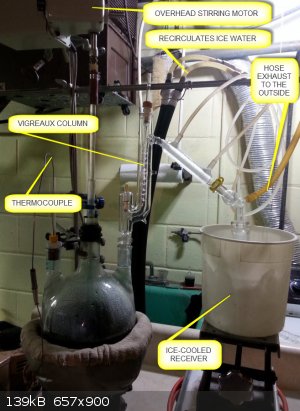 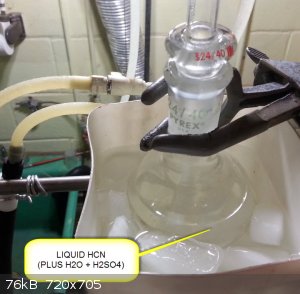 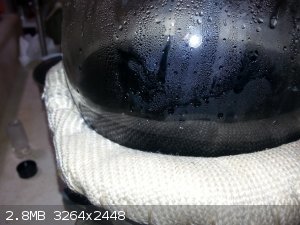 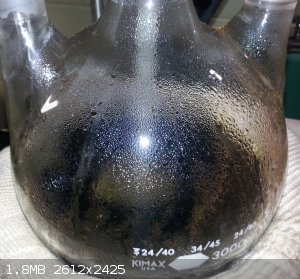 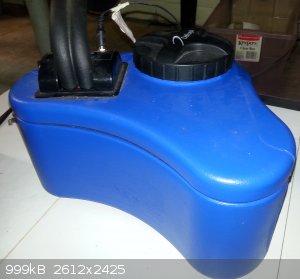
Attachment: Initial Stirred Solution.mp4 (4MB)
This file has been downloaded 934 times
Attachment: Max Rate of Collection.mp4 (4.8MB)
This file has been downloaded 924 times
[Edited on 31-3-2016 by Dan Vizine]
"All Your Children Are Poor Unfortunate Victims of Lies You Believe, a Plague Upon Your Ignorance that Keeps the Youth from the Truth They
Deserve"...F. Zappa
|
|
|
Magpie
lab constructor
    
Posts: 5939
Registered: 1-11-2003
Location: USA
Member Is Offline
Mood: Chemistry: the subtle science.
|
|
I knew HCN could be made using acid but felt the alkaline heating method was less risky. I struggled with the alkaline heating method for quite a
while. With the help of Engager I was finally successful. I agree that the way you have done it is sensible if you have the right equipment and know
what you are doing.
I can't open your movies. What software is required?
The single most important condition for a successful synthesis is good mixing - Nicodem
|
|
|
Dan Vizine
National Hazard
   
Posts: 628
Registered: 4-4-2014
Location: Tonawanda, New York
Member Is Offline
Mood: High Resistance
|
|
Hi Magpie,
I tried the alkaline method one time about 20 years ago. It was not a very successful attempt. The idea of the preparation being the purification
method also was what appealed to me about the acid method.
Most any player, even WMP should play them. VLC player is an open-source freeware download and excellent with many formats. The first video is
trivial. The second shows a peak production rate of a little better than 1 drop/sec.
"All Your Children Are Poor Unfortunate Victims of Lies You Believe, a Plague Upon Your Ignorance that Keeps the Youth from the Truth They
Deserve"...F. Zappa
|
|
|
Magpie
lab constructor
    
Posts: 5939
Registered: 1-11-2003
Location: USA
Member Is Offline
Mood: Chemistry: the subtle science.
|
|
Preparation of KCN via the Wagner Process as Modified by Engager - a carbothermic process
Introduction
I prepared KCN a few years ago using a modified Wagner process (ref 1). This process is based on the carbothermic reduction of potassium
ferrocyanide.
K4[Fe(CN)6] + K2CO3 + C --> 6KCN + Fe + CO2 + CO
I didn’t post about this at the time as I thought it best not to advertise how to make alkali cyanides. Now I see that others have posted methods
both on SM and YouTube. I think that the alkaline carbothermic methods, although more difficult, are inherently safer than those that generate HCN
gas as an intermediate, especially for the underequipped neophyte. That is why I have decided to now post my preparation.
I struggled for some time to get success. But with guidance and encouragement from Engager I finally achieved a modicum of success. The following
are my abridged lab notes.
Procedure
I weighed out the following:
•K4[Fe(CN)6]*3H2O (lab grade): enough to get 25.6g (8 parts) of the anhydrous salt
•K2CO3 (pottery grade): 8.36g (2 parts as Na2CO3)
•C(food grade activated charcoal): 0.64g (0.2 parts)
I dried the potassium ferrocyanide trihydrate and the K2CO3 for 1 hour at 145°C.
The ingredients were ground together in a mortar then placed in a 250 ml ceramic crucible with ceramic lid (a smaller crucible). This filled the
crucible 1/3 full, as the charcoal was very light and fluffy.
This was placed in a muffle furnace and heated per the following schedule of Engager:
10:50AM……………12°C (room temperature)
11:25AM…………..600°C
12:30PM…………..600°C
12:45PM…………..650°C
1:45PM................... 650°C
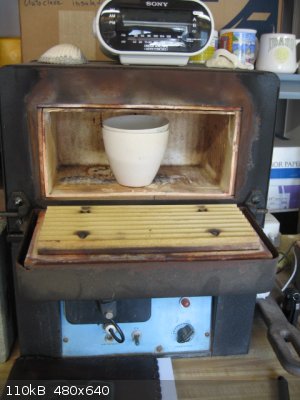
After cooling, inspection showed there was some carbon and product on the underside of the lid (dried drops). The product was dissolved in 50 ml of
boiling water that had been pre-boiled to remove oxygen. The solution was filtered into a 100ml RBF yielding a clear, slightly yellow filtrate. This
tested strongly for cyanide using the Prussian blue test (see below).
Aspirator vacuum was applied to remove water. Bumping was a problem so a Claisen adaptor was added to increase head space. Clear crystals began
forming on the bottom of the RBF with ~25 ml of liquid remaining. I then installed an ebulliator tube on argon to stop the bumping. This evaporation
took a lot of heat using a hot air gun. This was slow going but did eventually remove most all of the water. Crystals on the tip of the ebulliator
gave an intense Prussian blue! The crystals were very hygroscopic.
Prussian Blue Test Reagent for Detection of -CN
For the Prussian blue test the pH should be 5.5-6.5. Some Fe+++ ions must be present along with the ferrous ions. I dissolved some FeSO4*7H2O
crystals in 1 ml of water then added 2 drops of 0.5M FeCl3. The ideal Fe:CN mole ratio is 0.5.
Clean Up
I cleaned up the equipment and workspace using an aqueous solution of laundry bleach (sodium hypochlorite) (ref 2).
KCN + NaOCl --> KOCN + NaCl
To test for residual –CN I swabbed my hood ss catch pan with Prussian blue solution. Only a slight trace of blue (-CN) was detected.
Transfer of the Crystals to a Storage Bottle
I slurried out the crystals in the RBF using denatured alcohol onto a filter paper in a7cm Buchner funnel. They were dried with a little sucked air
flow. The weight of the crude crystal white KCN was 21.2g.
Assay of the Crude KCN Crystals
This was done using the Liebig AgNO3 titration method shown in Pierce & Haenisch (ref 3). The crystals assayed 36.7% KCN for a %yield of 28.7%.
References
1. http://www.sciencemadness.org/talk/viewthread.php?tid=23&...
(Engager’s post, bottom of p. 17)
2. Prudent Practices for Disposal of Chemicals from Laboratories, National Research Council et al (1983), p. 87.
3. Quantitative Analysis, by Pierce & Haenisch, 3rd ed (1951), p. 304.
The single most important condition for a successful synthesis is good mixing - Nicodem
|
|
|
clearly_not_atara
International Hazard
    
Posts: 2692
Registered: 3-11-2013
Member Is Offline
Mood: Big
|
|
http://www.nrcresearchpress.com/doi/abs/10.1139/v61-169#.VvB...
Can someone download this paper? If the reaction generalizes to glyoxylic acid it would be
CHOCOOH + NH2OH >> CO2 + 2H2O + HCN
Reaction occurs in water.
EDIT: Thanks, gdflp! The paper indicates that both glyoxylic acid and mesoxalic acid will give HCN by reaction with hydroxylamine. However only the
anti oxime decomposes at room temperature.
[Edited on 4-4-2016 by clearly_not_atara]
|
|
|
gdflp
Super Moderator
      
Posts: 1320
Registered: 14-2-2014
Location: NY, USA
Member Is Offline
Mood: Staring at code
|
|
Here you go.
[Edited on 4-4-2016 by gdflp]
Attachment: v61-169.pdf (731kB)
This file has been downloaded 677 times
|
|
|
skip
Hazard to Self
 
Posts: 54
Registered: 16-5-2015
Member Is Offline
Mood: No Mood
|
|
I've made sodium cyanide so many times it's not funny. About every time was at least a mole, using HCN. Over the years I've probebley made a few
pounds, perhaps more. I've never had any issues, even gotten it on my fingers(washed off right away). I will never post my synthesis because of fear
of repercussion. The first time I tried the synthesis I was scared to death and had a scuba mask on, as I gained experience the mask is gone and my
fear of cyanide considerably diminished . Now the HCN liquid is no joke, respect that stuff and protection is a must. It can be handled though if you
have good lab skill. Yea its deadly stuff but I think people freak out about it.
|
|
|
testimento
Hazard to Others
  
Posts: 351
Registered: 10-6-2013
Member Is Offline
Mood: No Mood
|
|
I have understood that using urea instead of ferrocyanide is much more cheaper and OTC method for producing alkali cyanides. The process involes about
molar ratio of urea and sodium carbonate with one mol of reductive carbon heated to 800-1000C for the reduction to take place. I performed a test with
these at small scale years ago, but I couldn't confirm if cyanide was produced, or how pure it was.
|
|
|
Chiron
Harmless

Posts: 22
Registered: 25-3-2016
Member Is Offline
Mood: No Mood
|
|
Polverone, I admittedly did not read the entire thread, just the first few pages. I'm not sure if it has already been mentioned but did you ever
consider using methanol instead of water for the evaporation component of your experiment? Cyanide salts dissolve less readily in CH3OH and it has a
lower evaporation point than water. Heat will generally speed up the reaction with the air to form cyanate, but at least with a lower boiling point
that would be reduced.
I guess hypothetically you could use a distillation setup to remove the methanol without air exposure to the cyanide, but would that much cyanate be
produced if you boiled it openly anyway?
|
|
|
chemplayer...
Hazard to Others
  
Posts: 191
Registered: 25-4-2016
Location: Away from the secret island
Member Is Offline
Mood: No Mood
|
|
Tried out another cyanide preparation today; this time using potassium ferrocyanide and fusing with potassium carbonate.
https://www.youtube.com/watch?v=E8lULpuQvg4
We'd tried this before using potassium ferrocyanide and sodium carbonate and had terrible results, so we were expecting the worst, especially as our
spare kitchen gas burner is on the brink of dying (too many aluminium chloride preps!).
Anyway, to cut a long story short it was surprisingly effective. We managed to isolate just over a gram of crystalline solid which according to the
tests we've done so far seems to be fairly pure potassium cyanide (but this is 18% yield). Getting the rest of the product out of the aqueous solution
is much harder using this method. But a lot more OTC than using sodium metal, so may be of interest...
|
|
|
skip
Hazard to Self
 
Posts: 54
Registered: 16-5-2015
Member Is Offline
Mood: No Mood
|
|
love you're video's . very good work. cheers mate.
|
|
|
Racconized
Harmless

Posts: 22
Registered: 27-11-2016
Member Is Offline
Mood: Yes
|
|
Hm the simplest way seems to be the ferrocyanide with a "weak" acid or diluted strong acid, the most appealing for me seems to be collecting the hcn
into an alcoholic solution of NaOH.seeing that many nitrile synthesis from halide and an alkali cyanide uses water and alcohol it wouldn't matter if
the resulting nacn is a bit wet right?
|
|
|
Dan Vizine
National Hazard
   
Posts: 628
Registered: 4-4-2014
Location: Tonawanda, New York
Member Is Offline
Mood: High Resistance
|
|
Quote: Originally posted by Racconized  | | Hm the simplest way seems to be the ferrocyanide with a "weak" acid or diluted strong acid, the most appealing for me seems to be collecting the hcn
into an alcoholic solution of NaOH.seeing that many nitrile synthesis from halide and an alkali cyanide uses water and alcohol it wouldn't matter if
the resulting nacn is a bit wet right? |
Quite correct. And the cyanide is always in excess, so approximate weights are plenty good.
When distilling HCN directly into cold, stirred base, EVERY SINGLE RUN THAT I EVER DID GAVE BROWN-BLACK POLYMERS along with the alkali cyanide.
IN CONTRAST, collecting the HCN first and then adding it drop-wise to cold, stirred base gave a very pale brownish solution.
I have no good explanation for the difference.
[Edited on 18-12-2016 by Dan Vizine]
"All Your Children Are Poor Unfortunate Victims of Lies You Believe, a Plague Upon Your Ignorance that Keeps the Youth from the Truth They
Deserve"...F. Zappa
|
|
|
Dan Vizine
National Hazard
   
Posts: 628
Registered: 4-4-2014
Location: Tonawanda, New York
Member Is Offline
Mood: High Resistance
|
|
I hear statements like this from time to time. I assume that the repercussion you fear is a liability-based one?
It makes me wonder. If Wikipedia tells me how to make cyanide or bromine or whatever, could I reasonably expect that the same would be true? Could I
expect that a court would hold them liable if I hurt myself? Common sense says no, but of course, the law is whatever the lawyers can convince the
judge or jury is true.
[Edited on 18-12-2016 by Dan Vizine]
"All Your Children Are Poor Unfortunate Victims of Lies You Believe, a Plague Upon Your Ignorance that Keeps the Youth from the Truth They
Deserve"...F. Zappa
|
|
|
aga
Forum Drunkard
    
Posts: 7030
Registered: 25-3-2014
Member Is Offline
|
|
Dan,
It is likely that the brand new users just read Wikipedia, hence the scant detail posted here.
Unlikely that you're responding to people who actually do any Chemistry, much less likely anything related to Cyanides, highly unlikely they ever
tried to make any.
The vast majority of posts on this board over the past year are like this.
|
|
|
Racconized
Harmless

Posts: 22
Registered: 27-11-2016
Member Is Offline
Mood: Yes
|
|
Quote: Originally posted by aga  | Dan,
It is likely that the brand new users just read Wikipedia, hence the scant detail posted here.
Unlikely that you're responding to people who actually do any Chemistry, much less likely anything related to Cyanides, highly unlikely they ever
tried to make any.
The vast majority of posts on this board over the past year are like this. |
Probably eitherway it seems that this forum is dying put and sadly, it seems to be one of few chemistry forums around with active members. That's just
how I see it though.
Anyway since cyanide is pretty dangerous or can be quite dangerous, are there any antidotes, which are legal (read somewhere amyl nitrates is a part
of the official cyanide antidote kit however it's illegal and can be given without needles or with needle but IM instead of IV.
I can just google it but I feel like this is a more fun and keeps the thread active 
|
|
|
Dan Vizine
National Hazard
   
Posts: 628
Registered: 4-4-2014
Location: Tonawanda, New York
Member Is Offline
Mood: High Resistance
|
|
Quote: Originally posted by Racconized  | Quote: Originally posted by aga  | Dan,
Anyway since cyanide is pretty dangerous or can be quite dangerous, are there any antidotes, which are legal (read somewhere amyl nitrates is a part
of the official cyanide antidote kit however it's illegal and can be given without needles or with needle but IM instead of IV.
|
None that I know of. The irony of an illegal antidote is palpable. That is nearly as lame as reading that cannabadiol oil (which is NOT psychoactive,
but DOES help treat a refractory form of epilepsy) was declared by the DEA to be a schedule I controlled substance. Seems that they need to find ways
to justify their jobs, now that they won the war on drugs. |
"All Your Children Are Poor Unfortunate Victims of Lies You Believe, a Plague Upon Your Ignorance that Keeps the Youth from the Truth They
Deserve"...F. Zappa
|
|
|
Dan Vizine
National Hazard
   
Posts: 628
Registered: 4-4-2014
Location: Tonawanda, New York
Member Is Offline
Mood: High Resistance
|
|
Quote: Originally posted by Racconized  | Quote: Originally posted by aga  | Dan,
Probably eitherway it seems that this forum is dying put and sadly, it seems to be one of few chemistry forums around with active members. That's just
how I see it though.
|
I thought that I was finding a little less actual chemistry recently. I hope it's just a statistical blip, though. This is the best chemistry forum
that I've found. Personally, if I didn't contribute here, I probably wouldn't anywhere. I'm not interested in being the smartest guy in a forum, and
here, I'm not, by a long stretch. |
"All Your Children Are Poor Unfortunate Victims of Lies You Believe, a Plague Upon Your Ignorance that Keeps the Youth from the Truth They
Deserve"...F. Zappa
|
|
|
Racconized
Harmless

Posts: 22
Registered: 27-11-2016
Member Is Offline
Mood: Yes
|
|
Quote: Originally posted by Dan Vizine  | Quote: Originally posted by Racconized  | | Hm the simplest way seems to be the ferrocyanide with a "weak" acid or diluted strong acid, the most appealing for me seems to be collecting the hcn
into an alcoholic solution of NaOH.seeing that many nitrile synthesis from halide and an alkali cyanide uses water and alcohol it wouldn't matter if
the resulting nacn is a bit wet right? |
Quite correct. And the cyanide is always in excess, so approximate weights are plenty good.
When distilling HCN directly into cold, stirred base, EVERY SINGLE RUN THAT I EVER DID GAVE BROWN-BLACK POLYMERS along with the alkali cyanide.
IN CONTRAST, collecting the HCN first and then adding it drop-wise to cold, stirred base gave a very pale brownish solution.
I have no good explanation for the difference.
[Edited on 18-12-2016 by Dan Vizine] |
How about the yields, what have you been able to get (average). Is the yields worth dying or almost dying for (Just joking, kinda). Or should I just
buy it (100g for 30usd)
|
|
|
| Pages:
1
..
27
28
29
30
31 |